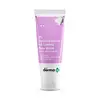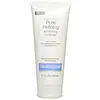What's inside
What's inside
 Key Ingredients
Key Ingredients

 Benefits
Benefits

 Concerns
Concerns

 Ingredients Side-by-side
Ingredients Side-by-side

Water
Skin ConditioningSodium Lauroyl Sarcosinate
CleansingCoco-Glucoside
CleansingCocamidopropyl Betaine
CleansingSodium Acrylates Copolymer
Decyl Glucoside
CleansingCaprylyl/Capryl Glucoside
CleansingSodium Methyl Cocoyl Taurate
CleansingGlycerin
HumectantCocamide Mea
EmulsifyingDisodium Laureth Sulfosuccinate
CleansingZinc Oxide 99.5%
Cosmetic ColorantCetrimonium Chloride
AntimicrobialNiacinamide
SmoothingAloe Barbadensis Leaf Extract
EmollientKaolin
AbrasiveSodium Hyaluronate
HumectantEthylhexylglycerin
Skin ConditioningPhenoxyethanol
PreservativePEG-12 Dimethicone
Skin ConditioningDisodium EDTA
Salicylic Acid
MaskingWater, Sodium Lauroyl Sarcosinate, Coco-Glucoside, Cocamidopropyl Betaine, Sodium Acrylates Copolymer, Decyl Glucoside, Caprylyl/Capryl Glucoside, Sodium Methyl Cocoyl Taurate, Glycerin, Cocamide Mea, Disodium Laureth Sulfosuccinate, Zinc Oxide 99.5%, Cetrimonium Chloride, Niacinamide, Aloe Barbadensis Leaf Extract, Kaolin, Sodium Hyaluronate, Ethylhexylglycerin, Phenoxyethanol, PEG-12 Dimethicone, Disodium EDTA, Salicylic Acid
Water
Skin ConditioningDecyl Glucoside
CleansingCetyl Alcohol
EmollientGlycol Distearate
EmollientSodium Laureth-13 Carboxylate
CleansingCocamide Mea
EmulsifyingDisodium Lauryl Sulfosuccinate
CleansingPolyethylene
AbrasiveCocamidopropyl Betaine
CleansingSodium Methyl Cocoyl Taurate
CleansingSalicylic Acid
MaskingGlycolic Acid
BufferingPolyquaternium-11
Linoleamidopropyl Pg-Dimonium Chloride Phosphate
Sodium PCA
HumectantPEG-150 Pentaerythrityl Tetrastearate
EmulsifyingHydroxypropyl Guar
Emulsion StabilisingDisodium EDTA
BHT
AntioxidantParfum
MaskingWater, Decyl Glucoside, Cetyl Alcohol, Glycol Distearate, Sodium Laureth-13 Carboxylate, Cocamide Mea, Disodium Lauryl Sulfosuccinate, Polyethylene, Cocamidopropyl Betaine, Sodium Methyl Cocoyl Taurate, Salicylic Acid, Glycolic Acid, Polyquaternium-11, Linoleamidopropyl Pg-Dimonium Chloride Phosphate, Sodium PCA, PEG-150 Pentaerythrityl Tetrastearate, Hydroxypropyl Guar, Disodium EDTA, BHT, Parfum
Ingredients Explained
These ingredients are found in both products.
Ingredients higher up in an ingredient list are typically present in a larger amount.
We don't have a description for Cocamide Mea yet.
Cocamidopropyl Betaine is a fatty acid created by mixing similar compounds in coconut oil and dimethylaminopropylamine, a compound with two amino groups.
This ingredient is a surfactant and cleanser. It helps gather the dirt, pollutants, and other impurities in your skin to be washed away. It also helps thicken a product and make the texture more creamy.
Being created from coconut oil means Cocamidopropyl Betaine is hydrating for the skin.
While Cocamidopropyl Betaine was believed to be an allergen, a study from 2012 disproved this. It found two compounds in unpure Cocamidopropyl Betaine to be the irritants: aminoamide and 3-dimethylaminopropylamine. High-grade and pure Cocamidopropyl Betaine did not induce allergic reactions during this study.
Learn more about Cocamidopropyl BetaineDecyl Glucoside is a glucose-based surfactant and emulsion stabilizer. It is created by reacting glucose with the fatty acids from plants.
Surfactants help clean the skin by trapping oil, sebum, and dirt to be washed away. As an emulsion stabilizer, it stabilizes the ingredients in a product by preventing them from separating.
This ingredient is biodegradable and non-toxic. This ingredient is commonly found in baby shampoos.
Decyl Glucoside is sometimes used to stabilize the UV filter Tinosorb.
Learn more about Decyl GlucosideDisodium EDTA plays a role in making products more stable by aiding other preservatives.
It is a chelating agent, meaning it neutralizes metal ions that may be found in a product.
Disodium EDTA is a salt of edetic acid and is found to be safe in cosmetic ingredients.
Learn more about Disodium EDTASalicylic Acid (also known as beta hydroxy acid or BHA) is a well-known ingredient for treating skin that struggles with acne and clogged pores. It exfoliates both the skin's surface and deep within the pores to help clear out buildup, control oil, and reduce inflammation.
Unlike AHAs (alpha hydroxy acids), salicylic acid is oil-soluble. This allows it to penetrate into pores which makes it especially effective for treating blackheads and preventing future breakouts.
Salicylic acid is also known for its soothing properties. It has a similar structure to aspirin and can calm inflamed or irritated skin, making it a good option for acne-prone skin that is also sensitive.
Concentrations of 0.5-2% are recognized by the U.S. FDA as an over-the-counter topical acne product.
It can cause irritation and/or dryness if one's skin already has a compromised moisture barrier, so it's best to focus on repairing that before introducing this ingredient into your routine.
While salicylic acid does not increase sun sensitivity, it’s still important to wear sunscreen daily to protect your skin.
If you are looking for the ingredient called BHA or Butylated Hydroxyanisole, click here.
Learn more about Salicylic AcidThis gentle cleansing and foaming ingredient is known for leaving a smooth feeling in skin and hair. It is made using coconut oil.
According to the manufacturer, it is soluble in water and has resistance to hard water, acid, and alkali.
Due to its coconut base, it may not be Malassezia folliculitis safe.
Learn more about Sodium Methyl Cocoyl TaurateWater. It's the most common cosmetic ingredient of all. You'll usually see it at the top of ingredient lists, meaning that it makes up the largest part of the product.
So why is it so popular? Water most often acts as a solvent - this means that it helps dissolve other ingredients into the formulation.
You'll also recognize water as that liquid we all need to stay alive. If you see this, drink a glass of water. Stay hydrated!
Learn more about Water